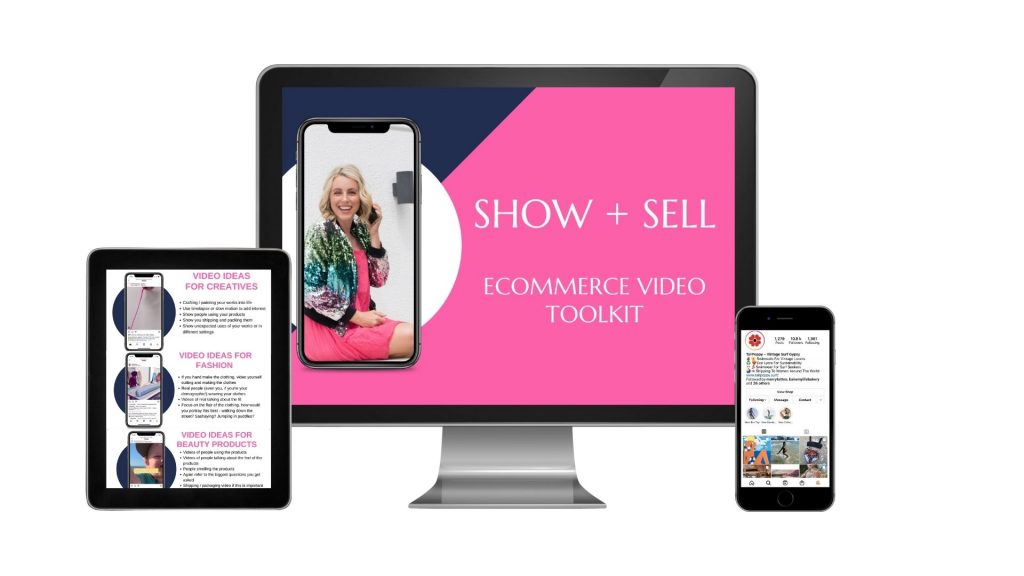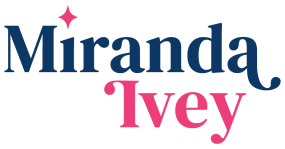So… you think it’s easy to create a $27 course? Some people’s brains work out things logically, other people’s are a bit like mine and there’s a bit of column A, column 8, column XYZ. I want to share the steps that I took to create my latest course.
- The Why
- The Transformation
- Getting started
- Getting sidetracked
- The tech set up
- Pricing & the offer
- Promotions
Step 1: The Why
I decided to create my latest online course Show + Sell for three reasons
-
After my interview with my former client Kirsten Jackson, I received an influx of followers on my Instagram account. A quick scope at them showed me that they weren’t using much video and/or hadn’t dipped their toe into Reels
-
For the past 3 years I’ve been simplifying how I teach people ads. For ecommerce, I’ve come up with a simple video ad strategy that works time and time again
-
For brands that are starting out, they need a repeatable system that they can learn and test. That way instead of always throwing spaghetti at the wall, they can start to have a plan and measure results.
Step 2: The Transformation
Based on the reasons why I wanted to create the course, I had to come up with the transformation that I was selling. It’s a simple formula and makes sense. People don’t buy modules and worksheets, they buy what they will deliver when the put these modules into practice. When paired with a time frame, this is powerful. You might see it look like this:
- “I went from X to Y in XX days”
- “How I made $XXX in just XXX”
- “Learn the system that saw me go from XXX to YYY”
I settled on “How to Create High Performing Videos without spending Any Money”
Most people have a phone and I’m going to give them ideas on how they can use that phone to create better videos. And once they have those videos… how to turn them into ads.
In my experience in Social Media & Ads Management, the number one thing that most people get wrong is that they think just posting any old thing will deliver results. But boring content is the #1 killer of engagement.
Step 3: Getting started
I’ve created courses before and I’ve done courses on creating courses. I started off by writing the content. That’s how I get my ideas out of my head.
This course actually started off as a booklet that people would download. It was a handy way to create the content because it meant that I could repurpose the workbook as separate workbooks & also onto slides to record.
Step 4: Getting sidetracked
I wish this was one of those blog posts where I say I just started at the start and ended at the end and it was all done. But seeing as it took me around 5 years to write my book because I had to get over certain beliefs (it’s all been done before, what have I got to add etc) it has taken me around 6 weeks amongst my other work.
Part of the issue was that although I’d done these steps over and over for Ads Intensive clients for years, I still had to create the content. It’s also a deviation of my current niche which is coaching women in the health & wellness industry to promote their courses and programs. However as I’m part creative / part course creator I just had to get this content out into the world. More than anything I knew this stuff works and I wanted to help more people with it.
Step 5: The tech set up
- Slides: I’ve moved over to using Canva for all my slides. They’ve got great templates and it’s easy to add design elements.
- Content: This was mainly screenshots & videos from Instagram. I used the screen recording feature on my phone, used AirDrop to send to my computer and dropped them into my Canva presentation.
- Video Recording: I use Loom.com for all my computer sceen recordings. I’ve been using it for a while so I pay $10 USD per month. I can record my screen and also do recordings of me if need be. It’s easy to download & edit the recordings too.
- Video Hosting: I host my videos on Vimeo.com. That way if all I need to do is add in a new thumbnail cover photo it’s super simple. My VA helped a lot with this.
- Course platform: Podia.com I started using Podia last year and although it doesn’t have all the bells and whistles as Kajabi it’s pretty good. My clients have given me feedback that they like the interface. I upload the worksheets directly to Podia and use the video link from Vimeo for videos.
- Sales Page: I have used LeadPages.com. Again, I’ve been using this system for years and it’s easy to work with. Podia does offer sales pages but sometimes it’s easier to go with the devil you know!
- Sales page images: These came from Canva as well. When selling an online course it’s a great idea to show ‘what you get’ and this is done through using the computer / iPad style of images. You can take screenshots of your covers and simply drag them over the icons as they are templates in Canva (see below)
- Shopping Cart: I have ThriveCart which is an excellent standalone shopping cart. However sadly all PayPal payments keep getting rejected!
- I could try using just credit card processing however when I’ve run direct to purchase ads in the past many people pay via PayPal. I’m the same! I love not having to get up for my card when I’m doing my online shopping. That being said, I’ve gone with Podia’s in built shopping cart. Not as easy as ThriveCart but they get instant access and it syncs with ActiveCampaign.
- Email System: There’s no point selling someone a course and not emailing them again! I wrote the emails in Google Docs & set up via an automation in ActiveCampaign.
To recap these are the systems I used:
- Canva
- Loom
- Lead Pages
- Podia
- Active Campaign
- Google Docs & Sheets

Step 6: Pricing and The Offer
While you sell a transformation, what makes people buy is the offer. That’s why you’ll often see the value of online programs being much higher than the cost. It’s also why people use bonuses to ‘value add’ and help people make those purchasing decisions.
Bonuses that are templates or Quick Start Guides often work really well. (I’ve got to admit after buying some online courses I’ve only used the bonus section).
I knew I wanted to deliver the same content that I’ve shared in 1:1s which I charge $330 per hour for, so the value of the program with added extras I put at $297.
For my quick start bonuses they have to do with taking the content and turning it into paid ads. I included my step by step template & video for setting up a traffic and conversion ad, a Power up your Instagram profile (because there’s no point running ads if your profile sucks!) video and an ecommerce product launch calendar.
I’ve put the course price at $27 even though the value is over $400. I wanted to test this ’tiny offer system’ and also to get more people rocking their instagram content.
Upsell: My 5 Step Ad Copywriting Formula & Instagram Hacks Bundle for $47 because I know people struggle with copywriting. If you’re using a system like ThriveCart it’s easy to add these in but Podia does offer upsells too which is good.
Bonus Offer: Everyone who jumps into Show + Sell will receive $100 off my upcoming September Four Week E-commerce Intensive where you’ll be guided through creating content & setting up your first ecommerce Facebook & Instagram Ad
Why do this?
Often these tiny offers are sold to give someone a good solid quick win. They are value packed because most people will simply buy this. If you then decide to run paid ads to the offer, people buying the program will help cover the costs of your ads. There’s not much wiggle room in this however it’s good to combine your tiny offer with upsells / one time offers as well.
Step 7: Promotions
Having an idea to create a course is one thing, finishing it (in my case!) is another. I was aiming to pre-sell this course but because I kept on adding to it, I wasn’t sure when it was going to be ready. Now that I’ve finished it my promotions will include – posts on Instagram, Instagram Stories, Podcast, Paid Ads, Email Marketing and more. Because it’s not a ‘launch specific’ type course, it will be available year round. I’ll be able to play with paid ads to see how they go.
Finishing up…
It doesn’t matter what you price an online course, the effort going in will be the same. I’ve poured a lot into creating this course and I can’t wait to see people jump in and try the system. It’s often said that it’s just as hard to sell a $97 course as it is a $997 course. Why? Because the steps are the same. It’s hard to sell a course without content and a sales page. I’ve done that and it doesn’t always work!
If you’re keen to check out the finished product Show + Sell you can do so here.
How have you created your courses? How long did they take? I’d love to know!

